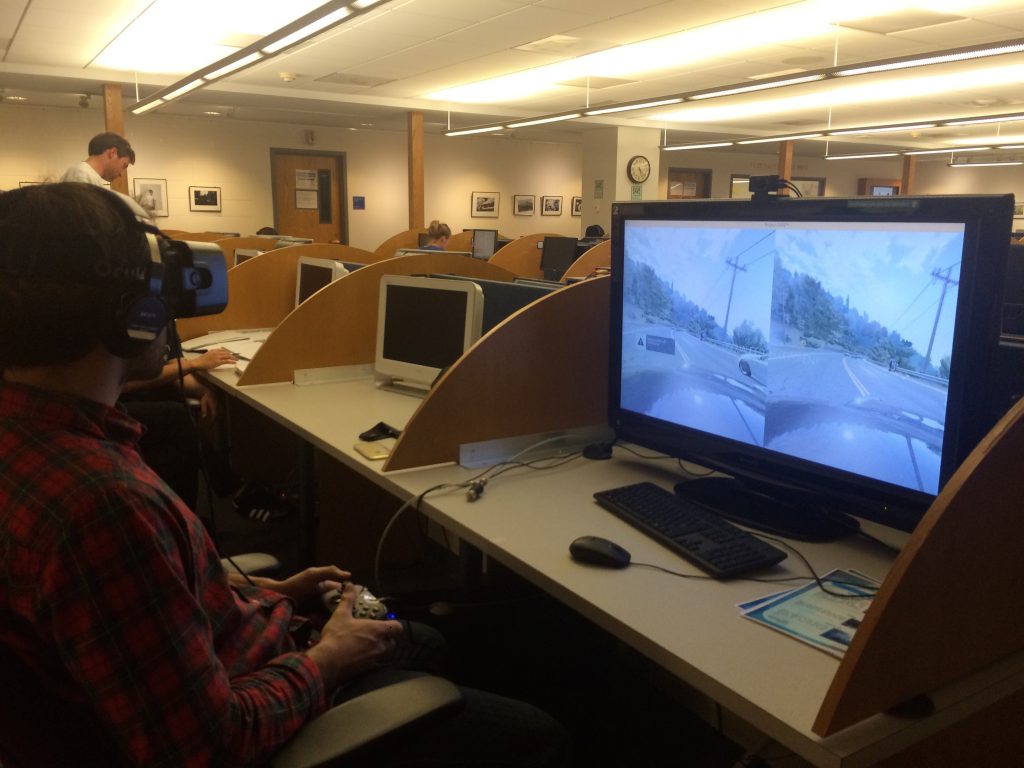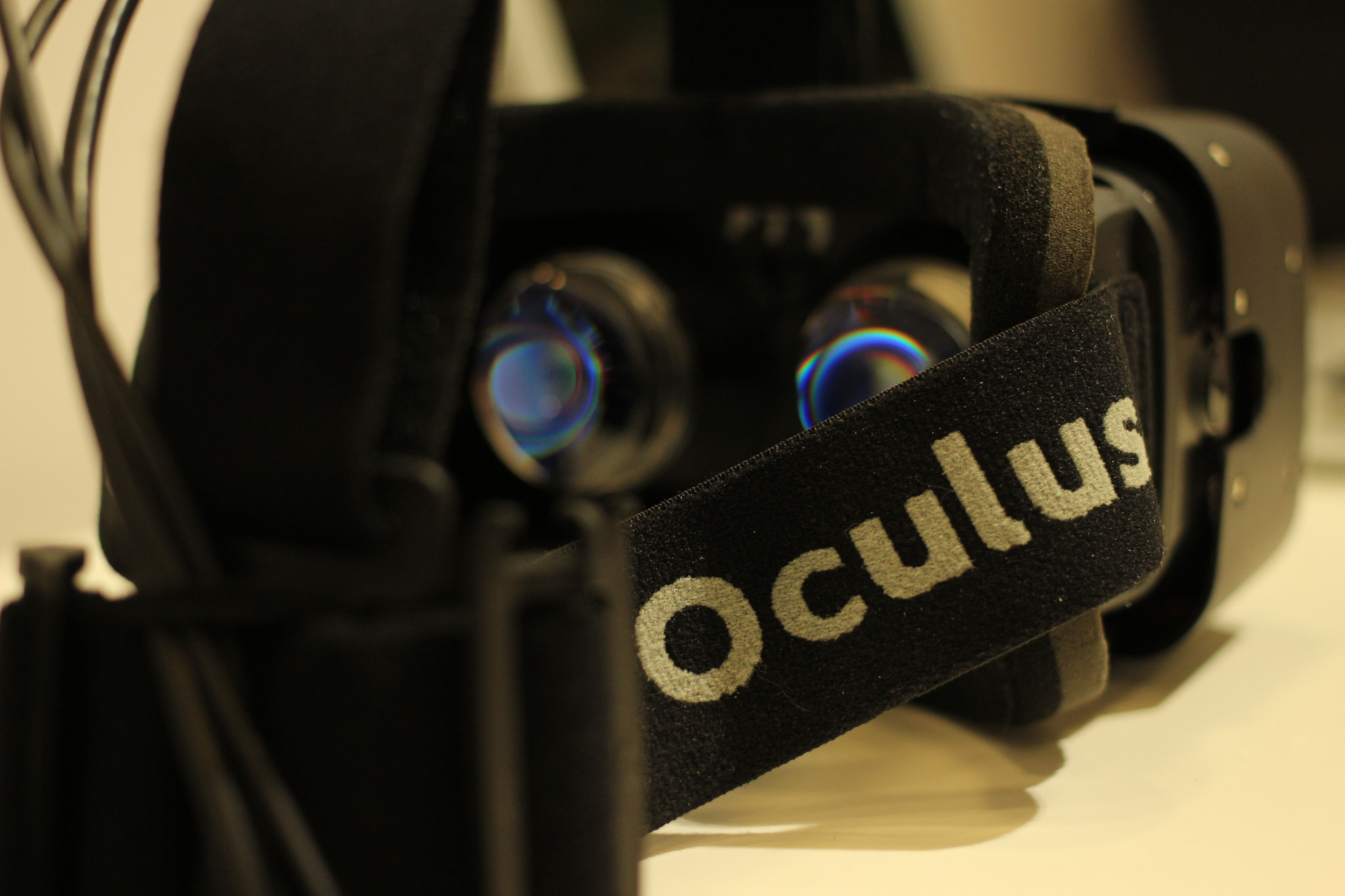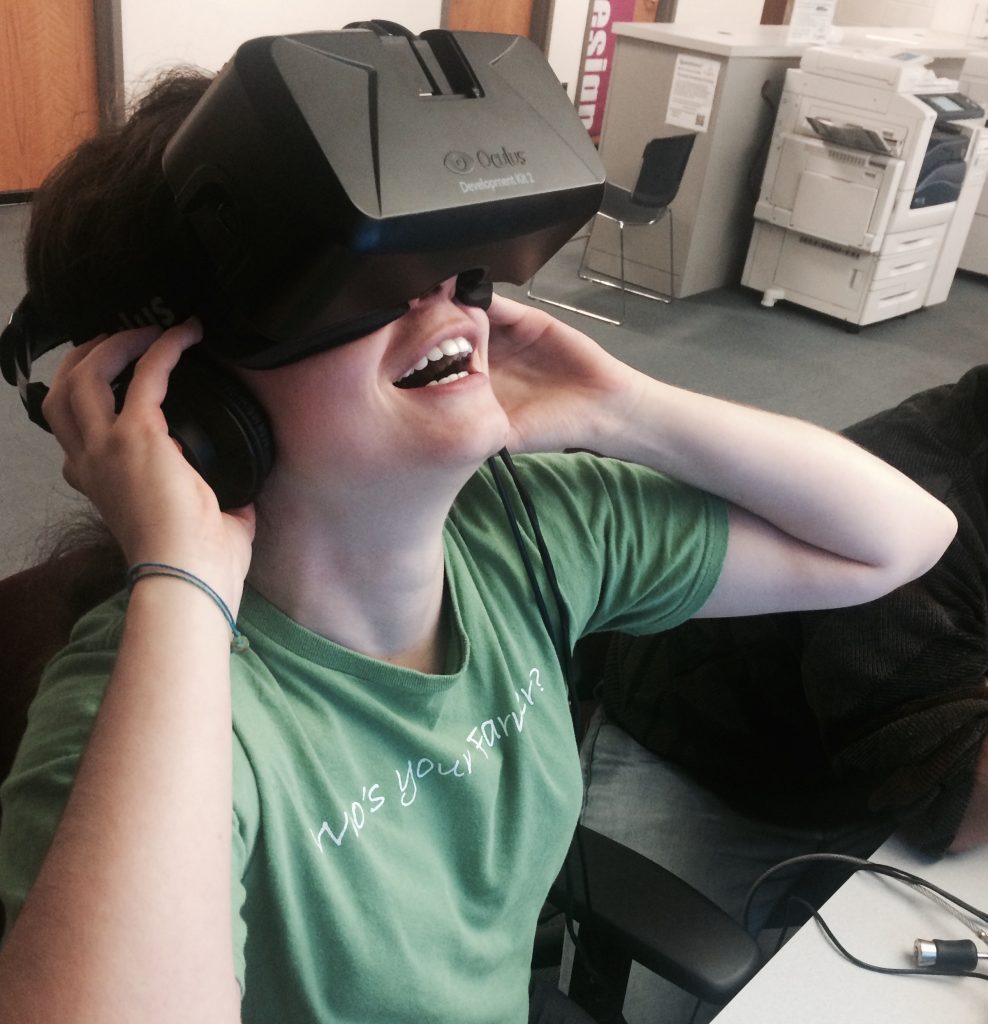Beth Marhanka isn’t a gamer. But when she visited UVa while on sabbatical, she had the chance to try out the Oculus Rift, an immersive virtual reality product currently in development for a consumer model. She was immediately blown away by her experience.
Beth, the department head of the Gelardin New Media Center, rode a virtual roller coaster and took a virtual walk down her street in Google Earth. She thought of what it would be like to virtually visit Tokyo and countless other cities, or practice public speaking in front of a virtual audience to alleviate stage fright before a presentation. Marhanka compared the VR experience to the feeling movie-goers must have had the first time they sat in the movie theater. It felt like something completely new and awe-inspiring. After her experience at the University of Virginia, Marhanka began to think about the impacts VR could have in education. When she got back to the first floor of Lauinger Library—Gelardin’s home—she invested in two Oculus Rift developer kits.
“The thing that makes Lau unique is that we serve everyone, not a specific department. It’s not just for art, film and media, or physics. Each space has their community and has a mission to serve those people, but our mission is to serve everybody. We have collaborations with different departments, but there needs to be a hub on campus, for the religion student who needs to make a film, or the bio student who wants to make a 3D model of a heart,” Beth said.
That’s where Gelardin comes in.
Gelardin has expanded immensely in the past year. The space behind the first-floor desk is now filled with everything from an NES (Nintendo Entertainment System) to a 3D printer. Anyone with a GUID can check out video-recording equipment, multiple video game systems, or one of over 80 video game titles. GU does not only provide the creative equipment; its staff members also teach across multiple creative platforms. GU students can also take a variety of courses in Adobe Suite programs, graphic design and the like, and have consultations with experts working in Gelardin for help on personal projects or multimedia schoolwork.
Thanks to the Caroon Family Technology fund, Gelardin purchased two Oculus Rift devices this year and now hosts 15-minute sessions on one of the VR devices. It’s nonchalantly set up on a desk at the back of Gelardin, and is hooked up to a large computer and flat-screen monitor.

The Oculus Rift setup lets onlookers look at a two-dimensional version of the world experienced within the headpiece (here, by my co-editor Mike Bergin).
Settling into the Oculus Rift is not as glamorous as the technology would make it seem. The Oculus is a clunky, protruding black headset with pads around the eyes that straps over the user’s head.This is certainly a far cry from the sleek science fiction technologies seen on the big screen. To complete the look, the gamer places a set of production-grade headphones over the headset straps and her ears. It’s hardly as fashionable and sleek as Google Glass, but the effects are far more incredible. At Gelardin, the VR assistant—a Gelardin employee—will help users calibrate the headset and choose an “experience” from the Gelardin menu of options.
Gelardin uses the developer pack for Oculus Rift, which means that games and experiences for the VR set are made by users in open-source communities. This permits experimentation on both ends: game designers get to play around with a whole new level of immersion when shaping their game experiences, and individual users or tech hubs like Gelardin get to experiment with what appeals most to the user. Gelardin has a robust selection for the budding technology. There are 8 currently-available experiences that include the horror game Doors of Silence, a survival game called Ark, a racing simulator, a roller-coaster simulator, the natural world simulator Ziran, two brain games, InMind VR and Neuro, and a solar system simulator, Titans of Space. (For full descriptions of these games, click here.)
I opted for a gentle lullaby into the world of virtual reality: Ziran, a 5-minute VR experience in which the user floats down a river on a boat and observes a series of natural elements. “Experience” is the perfect word to describe Ziran on the Oculus Rift— it is complete immersion, with ambient nature sounds playing through the headphones and a 360-degree natural environment complete with mountains, waterfalls, caves, and rapids projected through the headset.
Immersing oneself in the world of Ziran is surreal. While I felt my body in the office chair in the back of Gelardin, my mind, ears, and eyes were on Ziran’s boat and in Ziran’s world. If one were to watch the scene on a monitor—or even watch the user as she experiences Ziran—it would be uneventful. A first-person perspective from a boat going down a river with some nature surrounding it is hardly heart-pounding or thought-provoking. What takes your breath away, rather, is the ability while wearing Oculus to tilt your head upwards and stare directly at the sky, or to hear the waterfall once roaring in your left ear take up the full attention of both ears as you turn to (virtually) face it.
And to skeptics of the benefits of virtual reality (I considered myself to be skeptical going into this experience), I can say that I smiled in awe of Ziran’s world during the experience. I began to think of the possibilities that a calming virtual reality experience of this sort could have on stress reduction, relaxation, and quelling anxiety in a medical setting. While the sounds and visuals I experienced were virtual, the awe, joy, and creativity were not confined to the world inside of the Oculus Rift.
Other sensations and emotions popped up during our trial session, too: I felt a rush of excitement on the roller-coaster simulator (and a bit of dizziness, which is normal for more intense VR experiences), and convinced my friend Mike to try out the horror game. The ambient sounds, eerie lighting, and agency required of the player—who must use an Xbox controller to move around in the virtual space—were enough to cause Mike to break out in a cold sweat within minutes. Even after removing the headphones, the visual experience was too terrifying to bear, and he ended up opting out for a first-person racing game.
But entertainment and emotional effects are not all that the Oculus Rift can provide. The Oculus’ location in the library of a research university like Georgetown can lead to previously unimaginable learning experiences for professors and students alike. Imagine neuroscientists delving inside a model of the human brain, or SFS students viewing an international conflict as if they were standing right in front of the parties involved. Imagine an immersive component to a literature course in which you plug into Oculus to learn about a novel’s history by virtually traveling back in time.
Marhanka and the Gelardin team are in pursuit of creative, intellectual possibilities just like these. “You don’t have to have a reason in mind,” she said. “We don’t know what uses you will all think of…We’re providing it so that people can take it and run with it. You don’t have to know what you’re doing, you don’t have to be an expert. That’s why we’re here.”
Alongside Gelardin’s friendly technical support and the creative power of over 10,000 Georgetown students, faculty, and staff, the Oculus Rift housed on the first floor of Lau has immense potential to change learning, entertainment, and discovery on campus. I urge everyone with a 15-minute window of time to sign up for a session on the Oculus Rift. Let’s get our creative juices flowing, and begin to consider the ways in which these new technologies we have the privilege of experiencing can be used to enhance our educations on the Hilltop.
You can check out Gelardin’s page on the new Virtual Reality program here. For a comprehensive list of Gelardin’s (FREE!) services, click here.






